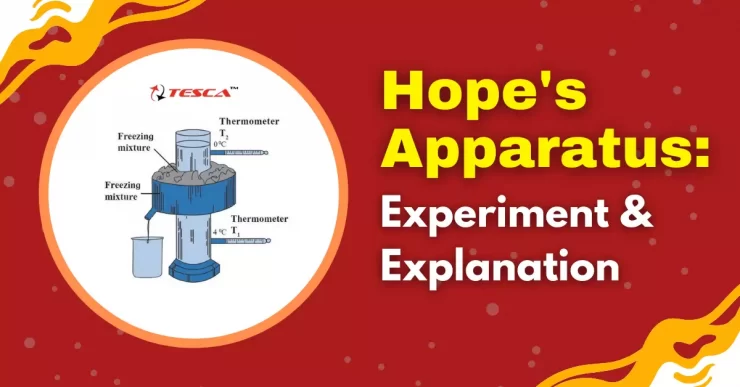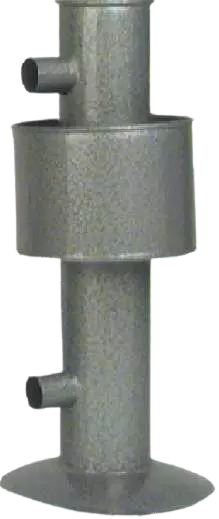Table of Contents
Hope’s Apparatus: Introduction
In life science, it’s a simple phenomenon; when a liquid is exposed to a particular temperature range, it expands.
But water, on the other hand, is an exception to this whole notion. When it is heated, instead of developing, it contracts until it reaches a temperature of 4 degrees Celsius from where it starts expanding—what a weird behavior by a state of matter. Of Course, you’d like someone to explain this anomaly to you?
Let us learn more about this absurd scientific event with the help of this blog authored by our specialized team.
Hope’s Apparatus is an instrument used in the experiment conducted to determine the water concentration, done by heating it at a low temperature.
It is an instrument that is cylindrical and used to indicate the temperature of the water. This instrument shows the temperature of the most excellent density of water, and it maintains the shape of a vertical vessel surrounded by water.
It is surrounded by water around the middle by a trough of ice.
Thomas Charles Hope, an eminent professor of chemistry who gave Hope’s Apparatus, explained why icebergs don’t melt and float in the water.
Working of Hope’s Apparatus:
This instrument consists of a glass cylinder that is full of water. In the middle of the water, a belt-shaped open-face is designed to receive a mixture of snow and salt.
The mix of snow and ice produces a freezing environment—the lowest temperature of the middle zone of the water present in the cylinder. Further, two thermometer recordings are inserted on the top and bottom of the cylinder to record the value of the top and the base temperature.
When it starts pulling the water, the middle region becomes tense, and when the lower thermometer starts falling and temperatures go to 4 degrees Celsius. After reaching this temperature, the cooling further diminishes the density of the water, and the water rises.
The upper thermometer also reaches 4 degrees Celsius, and it meanwhile comes to the lowest freezing point.
After getting the freezing point, the lower thermometer also falls, and the water in the cylinder becomes frozen. The more dense water is collected at the bottom at the recorded temperature of 4 degrees Celsius.
Irrespective of the temperature range when a liquid is heated, it is meant to expand. But water is not the same when heated as instead of developing, it contracts.
By heating water at 0 degrees Celsius, it contracts until the temperature rises to 4 degrees Celsius. When heated further after 4 degrees Celsius, the water, like other liquids, starts expanding.
This phenomenon is known as the anonymous behavior of water wherein the abnormal property of the water is observed from 0 degrees Celsius to 4 degrees Celsius.
Thomas Charles Hope was a scientist who devised the dynamic but straightforward arrangement widely known as the hope separators to demonstrate the abnormal behavior of water.
This device consists of a long cylindrical jar that opens on each side of the cylinder. The machine begins at the top and the other one at the bottom of the pot. In these openings, two thermometers are inserted.
After that, a tight cylindrical trough which is made up of metal is fitted on the jar. This trough is placed in the center of the cylindrical jar.
On the attacks of innings of this cylindrical jar, two thermometers are fitted, one at the bottom, called T1, and the other at the top of the pot, named T2. After the thermometers are inserted, the central portion of the cylindrical,
The trough that is present in the vessel is filled with a mixture of ice and kitchen salt.
Study of the strange behavior of water using Hope’s Apparatus:
The Anomalous expansion of water is regarded as the abnormal property of the water that is the same when water starts to expand instead of contracting when the temperature is changed from 4 degrees Celsius to degree Celsius.
When the heat rises, the temperature of any liquid does grow. Still, the abnormal property of water starts expanding when the temperature is freezing, and it becomes less dense in that state.
The density of the water is maximum at the 4-degree Celsius temperature, and the density decreases below 4 degrees Celsius.
As the temperature freezes, the thickness of water becomes lesser due to the water molecules transforming into an open crystal structure in which it retains solid form.
Because of the abnormal property of the water, we can study the Anomalous expansion of water with the help of Hope’s Apparatus. When the water temperature reaches 4 degrees Celsius, it remains at the surface of the lake, river, or sea.
The water starts expanding because of the decrease in temperature from 4 degrees Celsius to 0 degrees Celsius.
At this stage, the water is less dense, and this is why it remains on the surface. It reaches a stage when it is ice, and ice is less thick than water, so a thin layer of water that remains on the water’s surface becomes frozen; thus, it floats on water.
As a result, the water at the top freezes, and the bottom remains in a liquid state.
How to record the anomalous behavior of water by using Hope’s Apparatus?
The study of the anomalous behavior of water is essential, and we can study it by using Hope’s Apparatus. These are the steps through which we can check the anonymous behavior of water:
⮚ In Hope’s device, the glass vessel is filled with cool water and should be filled before an hour of experimenting.
⮚ After that, a cooling mixture is prepared by mixing the crossed eyes and kitchen salt so that it helps in identifying the changing properties of water with the increase and decrease in temperature.
⮚ After that, two thermometers are inserted into the holes in the Apparatus, respectively. Hope’s Apparatus is isolated.
⮚ After this, the inner cylinder of the device is filled with prequel water. The outer cylinder part of the device is filled with the cooling mixture.
⮚ The difference is when the water starts to change. A change in the temperature can be observed by using the thermometers. These are inserted at the bottom and top of the device.
⮚ When we start experimenting with Hope’s device, the temperature of both thermometers is identical. Still, eventually, it starts to progress. The thermometer, which is at the bottom of the vessel, remains constant at 4 degrees Celsius. Still, the thermometer at the top records the continuous fall in the temperature till it reaches zero degrees Celsius remains the same.
⮚ It is the stage when we observe the Anomalous expansion of water as it starts to expand when the temperature reaches 4 degrees Celsius.
Hope’s Apparatus Observation:
Professor Thomas Charles Hope published a paper, “Experiments and Observation Upon The Contraction Of Water By Heat And Low Temperatures,” in which the field shows that the maximum density of water is at 4 degrees Celsius.
It indicates the reason behind the congregation of fish at the pond’s bottom in the freezing weather. In Hope’s apparatus, a trough of a frozen mixture is placed in a glass cylinder surrounded by water.
In the cylinder, two holes are present at the top and the bottom of the cylinder. With this, we can insert the thermometer to find out the temperature of the water.
The change in the behavior of water from zero degrees Celsius to 4 degrees Celsius is also known as the anomalous behavior of water. It refers to the fact that, unlike other substances, water expands.
It is frozen. With the increase of the temperature, the density of the water also increases. It reaches a maximum of 4 degrees Celsius, where the water starts to expand.
It is the stage when the ice is less dense, and this is when it starts floating in the water. Instead of contracting, it starts to expand at the temperature between 4 degrees to 0 degrees Celsius.
It is also known as Anomalous expansion of water, an abnormal property of water—usually, any kind of liquid changes by contacting the cooling temperature and becomes denser.
However, the case with water is just the opposite as ice becomes low density with cooling temperature and floats on water.
Let us discuss the experiment in detail so that we can understand the whole process in a better way:
When the experimentation is done initially, the thermometer shows the same reading, around 12 degrees Celsius. When the freezing mixture is filled in the trough, the water at the central part of the jar starts losing heat, and the temperature begins to cool.
The density after water increases and the volume of the water decreases, which leaves the central portion of the water layer to become dense, and then it starts moving downwards.
While moving downwards, the lighter layer of water starts displacing towards the central portion of the jar.
A water star is formed, and the thermometer (T¹) records the rapid fall in the temperature until it reaches 4 degrees Celsius. Now the density of the water is at its maximum.
It happens because the temperature doesn’t change. Stage the water is at the Central portion of the jar.
When the Anomalous expansion of water is seen as the water starts expanding and the density of the water decreases, and the volume of the water increases resulting in the water moving upwards.
At this stage, the thermometer records the fall in the temperature. After this, the dense water now remains on the lower portion of the jar, and the thermometer (T²) stays unchanged.
The temperature that is recorded at the lower amount of the pot remains at 4 degrees Celsius. On the other hand, the water present on the top part of the jar continues to decrease and reaches below 4 degrees Celsius.
The water expands, and its density decreases as the temperature of the water decrease from 4 degrees Celsius to zero degrees Celsius.
In this process, we observe that when the water temperature decreases from 4 degrees Celsius to zero degrees Celsius, it expands, unlike other liquids. Along with that, the density of the water also decreases.
Thus, the low-temperature water rises to the surface of the top of the jar and starts forming a thin layer of ice.
The density of the water base is lesser now than the density of water when it was at 4 degrees Celsius, which is why the ice starts floating on the surface.
Show the change in the temperature in the thermometer(T¹)record for degrees Celsius while the thermometer records the fall in temperature 20 degrees celsius.
We can observe the abnormal property of the water from 4 degrees Celcius to 0 degrees Celsius.
It is why the surface water of the lake, river, sea, etc., is frozen in cool temperature, whereas the bottom of the water body remains in its liquid state.
With the help of this experiment, it proved that water has an abnormal property of the water. It has also been observed that the icebergs do not melt in water due to anomalous properties of water.
Hope’s apparatus: Review
Here we serve you a conclusive review of Hope’s apparatus regarding its efficacy and accuracy; over a hundred successfully conducted experiments.
The anomalous behavior shown by water around temperatures like 0 and 4⁰ Celsius can be well observed and elaborated through Hope’s experiment.
The apparatus is applicable in high school and college laboratories to demonstrate students’ water anomalies and quench their curiosity.
The change in the behavior of water between zero degrees Celsius to 4 degrees Celsius is known as the anomalous behavior of water.
So unlike other substances, water expands when it freezes, and Hope’s apparatus is the best way to demonstrate this anomaly.






Add comment